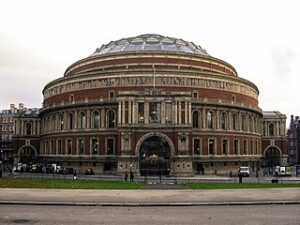
Directly across from the Albert Memorial, on the other side of Kensington High Street, stands a solid brick building built in keeping with Prince Albert’s dream for a central hall and a district to promote the arts and sciences.
The Great Exhibition of 1851 was the first step in making Albert’s vision a reality. When the exhibition closed, it had generated a profit of £186,000 [about £21 million pounds today]. The Royal Commission used £155,000 of the profits, with another £177,500 allocated by the government, to purchase a little over 86 acres of private land and markets to create the district then called Albertopolis. In 1857 the Victoria and Albert Museum opened, the first dedicated structure in the new district.
After Albert died in 1861, there were plans for both the Memorial and a Central Hall, but there wasn’t enough funding for both. The Royal Commission donated the land, and said if planners could raise £150,000 of the required funds, the Commision would donate the remainder. Planners sold seats to the opening for £100 pounds each. Queen Victoria purchased two boxes of ten seats each. These were later combined to make the Royal Box.

In 1867 Queen Victoria laid the foundation stone and announced the new building would be the Royal Albert Hall of Arts & Sciences. The Grand Opening took place in 1871 with Queen Victoria and the Prince of Wales in attendance.

The building is an interesting feat of engineering. The main wall is just over three inches thick and constructed of Cowley stocks laid in Portland cement, faced with six million red bricks ornamented by 80,100 terracotta blocks. Wrapped around the exterior is a terra-cotta frieze illustrating the Triumph of Arts & Letters.

The ceiling is an iron and glass dome that rests on a grooved iron plate on top of the wall. It’s the largest unsupported dome in the world. The dome was built in Manchester, then dismantled and brought down to London by canal. The dome is lovely and lets in good light, but it distorts the sound causing a 5-6 second reverberation. People in different seats experienced variable sounds. There were efforts to cover the glass, but to no avail until December 1968 when workers began installing fiberglass acoustic diffusers with their now well-known mushroom shape. In 2001 there were 85 diffusers in the ceiling.
Acoustical issues were fully resolved in 2019 with the installation of a £2 million single room speaker system providing uniform sound throughout the auditorium.

Behind the stage stands the famous pipe organ originally constructed by Henry Willis. At the time of completion, it was the largest organ in the world. It features 9,999 pipes, the largest of which is 42.5 feet long and weighs over a ton.
The Albert Hall is a multi-purpose venue that hosts multiple music venues, films, speeches, tennis matches, the Cirque de Soliel, and many other events. In 2018, there were 401 events in the auditorium. Many performers return. Eric Clapton has presented 200 shows, for example.
The PROMS, originally termed Prominade Concerts, are a series of concerts spread over eight weeks of summer. Henry Woods founded the event as a way to bring classical music to the masses by pricing tickets at 1 shilling. Today, patrons can still purchase standing tickets for the event. In 1927 the BBC began its sponsorship, and now broadcasts the concerts on BBC-Radio 3.
The most interesting piece of Albert Hall trivia I ran across concerns the Beatles. In 1967 the Beatles released Sgt. Pepper’s Lonely Hearts Club Band. One of the songs, A Day in the Life, mentions the Albert Hall:
‘I read the news today oh boy
Four thousand holes in Blackburn, Lancashire
And though the holes were rather small
They had to count them all
Now they know how many holes it takes to fill the Albert Hall
I’d love to turn you on’
Ernest O’Follipar, Chief Executive of the Albert Hall, was not amused by the association and wrote to complain that the lyrics contained inaccuracies that could be catastrophic to the Albert Hall’s reputation, specifically, the lyrics implied there were 4,000 holes in the Royal Albert Hall, that the Hall was located in Blackburn, Lancashire, and that the singer wanted to ‘turn on’ the Royal Albert Hall.
John Lennon addressed his reply to “Prince Albert and friends.” He declined to make any changes to the song.
The Albert Hall Council voted to ban the performance of A Day in the Life in the Albert Hall.
🎼🎼🎼
Royal Albert Hall by Bene Riobó
Opening of Royal Albert Hall, 1871.
Royal Albert Hall from center of gallery [mushrooms] by © User:Colin / Wikimedia Commons / CC BY-SA-4.0
The Organ, 1871.
Other Photos by Author.
“Royal Albert Hall was Furious.” Royal Albert Hall. Apr. 1, 2015.

Sandra Wagner-Wright holds the doctoral degree in history and taught women’s and global history at the University of Hawai`i. Sandra travels for her research, most recently to Salem, Massachusetts, the setting of her new Salem Stories series. She also enjoys traveling for new experiences. Recent trips include Antarctica and a river cruise on the Rhine from Amsterdam to Basel.
Sandra particularly likes writing about strong women who make a difference. She lives in Hilo, Hawai`i with her family and writes a blog relating to history, travel, and the idiosyncrasies of life.

